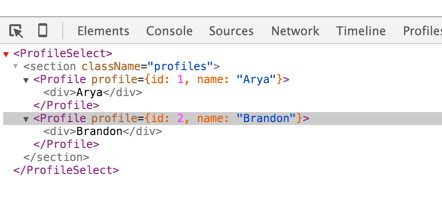I <3 React! Seriously, it’s great.

It mixes really well with ES6, and while it takes a while to understand the nuances, once you get to grips with it – even a little – it pays off.
Today was a very productive hour, which started with me reluctantly opening my laptop in bed. I wasn’t very excited to carry on after last night’s fiasco, but I’ve made up for it today I think.
I’ve not got a huge amount done (just one small commit) but what’s there has lead me to learn a lot about React and ES6.
Mocking with Lumen
Lumen (or rather Laravel, really) allows for very quick mocking of API in the app/routes.php file. I’ve got a simple API structure up and running to serve out the data for the user profile selector:
$app->group(['prefix' => 'api/profile'], function () use ($app) {
$app->get('/', function() use($app) {
return response()->json([
'profiles' => [
[
'id' => 1,
'name' => 'Arya'
],
[
'id' => 2,
'name' => 'Brandon'
]
]
]);
});
});
Reactive Components
I now have a simple component structure set up in react, and I’m rendering my profile selector like so:
// Bloon/ProfileSelect.jsx
import React from 'react';
import $ from 'jquery';
import Profile from './Profile';
class ProfileSelect extends React.Component {
/**
* ProfileSelect Constructor
*/
constructor(props) {
super(props)
this.mounted = false;
this.state = { profiles: [] };
}
/**
* componentDidMount event handler - fetches
* the component state via AJAX
*/
componentDidMount() {
this.mounted = true;
Promise.resolve(
$.get('/api/profile/')
)
.then(function(data) {
if (this.mounted === true) {
this.setState({
profiles: data.profiles
})
}
}.bind(this))
.catch(function(err) {
console.log(err);
});
}
/**
* componentWillUnmount event handler
*/
componentWillUnmount() {
this.state = {};
this.mounted = false;
}
/**
* render handler
*/
render() {
return (
<section className="profiles">{
this.state.profiles.map(profile => <Profile key={profile.id} profile={profile} />)
}
</section>
)
}
}
export default ProfileSelect;
In the above snippet, we consume our API method and keep track of our component mount state. This means our component state is handled asynchronously and allows it to re-render cleanly whenever the AJAX returns.
I’m not sure how efficient this is in the long term, I’ll need to investigate ways to streamline the access of the data from our PHP backend to React.
The thing I was most excited to discover is in our render function:
render() {
return (
<section className="profiles">{
this.state.profiles.map(profile => <Profile key={profile.id} profile={profile} />)
}
</section>
)
}
 Tasty!
Tasty!
This is just beautiful to me. In short, we render our component as an HTML section element, and inside it we map each of the profiles returning a Profile component.
We do this so cleanly using ES6 arrow functions
And our Profile component looks like this:
// Bloon/Profile.jsx
import React from 'react';
class Profile extends React.Component {
render() {
return <div>{this.props.profile.name}</div>
}
}
export default Profile;
In Chrome, using React Developer Tools, we can can see our React components in the virtual DOM:

It’s onwards and upwards from here. I’ll flesh out the UI in the days to come which will give me a chance to mock the rest of the API. Following that I’ll go back and fill in the gaps of the API and then finalise the functionality.
Today’s Observations
- React and ES6 seem to work well but there’s lots of room for improvement, this is apparent to me after only a few hours.
- Also, on React, I think they should take a leaf out of Meteor’s books in terms of allowing more tightly coupled data bindings with a backend API
- Shoutout to Browserify and Babelify for making everything so easy! Starting to really appreciate its benefit now.
- Need to think about how to speed up build time with gulp. Hmm.
- Stats for today: 1 commit, time spent 1h 17m 28s